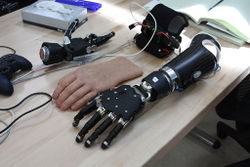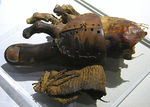Prosthetics
Prosthetics is the making and fitting of artificial body parts. The practice has advanced immensely since the wood and steel devices of the middle ages that seemed to be more of a nuisance than actually help. Now they have been made lighter and stronger with more usefulness to the wearer. In fact, in the 2008 Olympic games famous amputee runner Oscar Pistorius was denied qualification because his prostheses gave him an artificial advantage over other “natural” athletes. We have defiantly had many advancements to make amputees lives easier.[1]
Types Of Prosthetics
There are many different types and styles of prosthetics varying and depending on the task you are going to put it to hand and on the amputation. [2] You May ask, "what is a prosthetic"? A prosthetic is a device, either external or implanted, that substitutes for or supplements a missing or defective part of the body. [3]. A type of prosthesis called a cosmesis is made to be "just for looks" and has little or no function; artificial hands often fall into this category. Other prostheses are highly functional and are not really meant to look good but be there for a more functional reason! Artificial legs, designed to be covered by pants and are sometimes nothing more than metal rods and wires. Although we haven't really gotten to the point where prosthetics are more functional and useful than your God-given arms, there have been some pretty creative and useful designs.
There are four main types of artificial limbs:
Transradial Prosthesis - an artificial limb that replaces an arm missing below the elbow. The two main types of prosthetics available for that. Cable operated limbs work by attaching a harness and cable around the opposite shoulder of the damaged arm. The other form of prosthetics available are robotic or myoelectric arms. These work by sensing, with electrodes, when the muscles in the upper arm moves, causing an artificial hand to open or close.[4]
Transhumeral Prosthesis - an artificial limb that replaces an arm missing above the elbow. Transhumeral amputees have some of the same problems as transfemoral amputees, due to the similar issues that are associated with the movement of the elbow. This makes mimicking the correct motion with an artificial limb very difficult.[4]
Transtibial Prosthesis - an artificial limb that replaces a leg missing below the knee. Transtibial amputees are usually able to regain normal movement faster than someone with a transfemoral amputation, because there is still a large part of the leg and knee left so there is no need for an artificial joint, which allows for easier movement.[4]
Transfemoral Prosthesis - an artificial limb that replaces a leg missing above the knee. Transfemoral amputees can have a very difficult time getting back to their normal movement. In general, a transfemoral amputee has to use around 80% more energy to walk than a person with two whole legs. This is because the complexities in movement with the knee. There are now newer and more improved designs, after involving hydraulics, carbon fiber, mechanical linkages, motors, computer microprocessors, and trying to replicate normal movement using those electronics.[4]
Evolution of Prosthetics
Prosthetics have a late history going all the way back to 950B.C. For example there was a mummified women was found with a big toe prosthesis. Although it didn't look or function like the technologically advanced ones that we have today it most likely served it function.
Middle Ages
The Dark Ages technology with prosthetics didn't increase much other than the hand hook and peg leg. Most prostheses of the time were designed to cover deformities or injuries sustained in battle. A knight would be fitted with a prosthesis that was designed only to hold a shield or for a leg to fit in the stirrups of a horse, without caring for it to function properly. Outside of battle, only the rich and lavished ones were lucky enough to own a peg leg or hand hook for daily functions. most of the designers of this time for prosthetics where watchmakers and armorers who would collaborate to make these devices[1]
1500's
In 1508, German mercenary Gotz von Berlichingen got a pair of "advanced" iron hands made after he lost his right arm in the Battle of Landshut. The hands could be maneuvered by connecting them with the hand that moved by relaxing a series of releases and springs while being suspended with leather straps. After that there where many other notices about other people who were able to do the unbelievable with their prosthetics.[1]
17th through 19th centuries
In 1696, Pieter Verduyn developed the first below-knee prosthesis that didn't lock. It later became the blueprint for current joint and corset device. In 1843, Sir James Syme discovered a new amputation method that that enabled them to leave the ankle and they didn't have to involve amputation of the thigh. This concept was greatly loved among the amputees because it gave them hope to walk gain with a foot prosthesis rather then a whole leg[5]
Current
There have been many technological advancements with prosthetics since the peg legs. New prosthetics are made on the biomechanical. With electronic sensors that are attached to remaining muscles on the arm to control the biomechanical prosthesis. There are also private prosthetic companies that have taken to the race creating ones made of lighter materials like carbon fiber and aluminum to make it mimic the real human hand as much as possible. For example Nike, in working together with a prosthetics designer and manufacturer Ossur, made out of a high-tech material called Aeroply which enables the wearer more maneuverability and balance with Ossur’s carbon fiber blade prosthetic leg that Olympic runner Oscar Pistorius[5]
Video
MIT Media Lab's Hugh Herr explains how he looks to nature when designing and creating new bionic appendages. The amputee and passionate rock climber discusses how his biomechatronics division is developing the technologies that aim to increase human physical capabilities with a prosthetic.
References
- ↑ 1.0 1.1 1.2 Davis, Kwon.Life & Limb: The Evolution of Prosthetics Gear Patrol. Web. last accessed on November 6, 2016.
- ↑ Woodford, Chris. Prosthetic Limbs Explain That Stuff. Web. last-modified November 12, 2015.
- ↑ prosthesis Dictionary.com. Web. last accessed on October 22, 2016. unknown author
- ↑ 4.0 4.1 4.2 4.3 Prosthetics Wikipedia. Web. last-modified on October 21, 2016. unknown author
- ↑ 5.0 5.1 Modular Prosthetic Limb Johns Hopkins. Web. last accessed on November 7, 2016. unknown author.
| ||||||||||||||||||||





